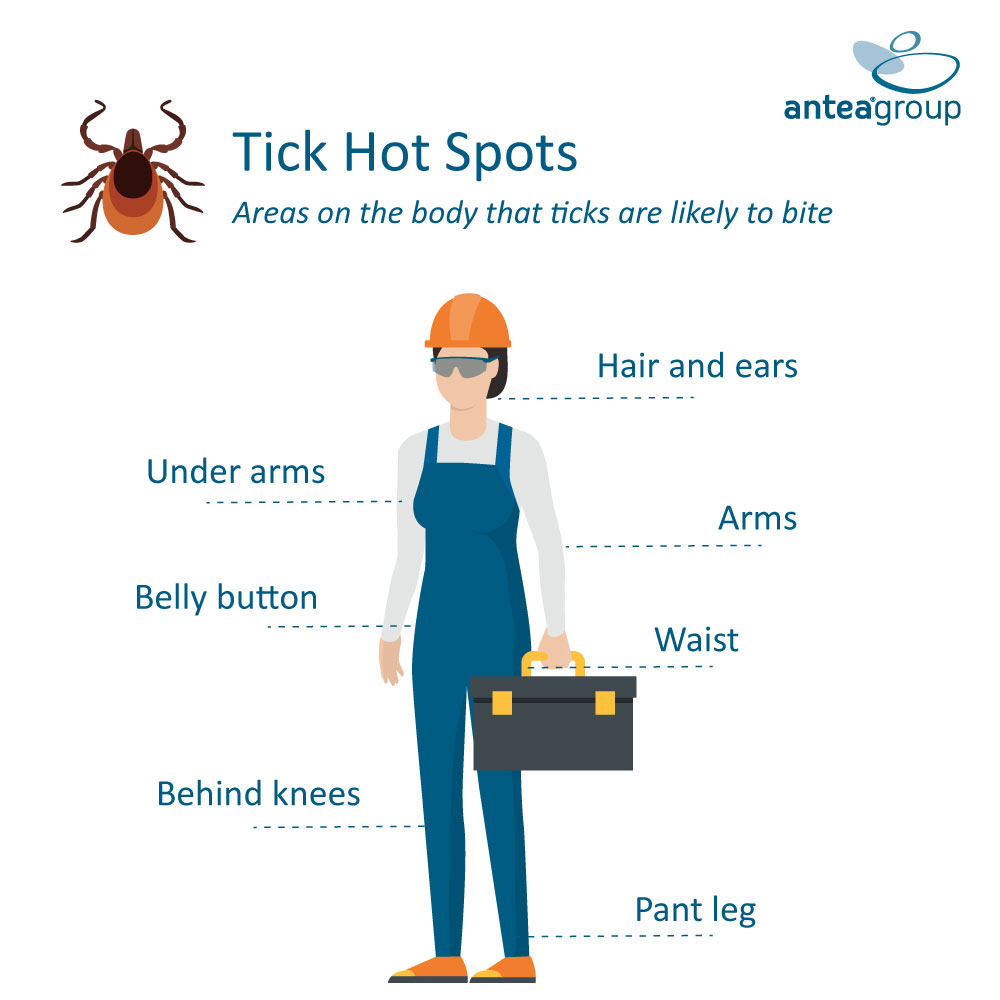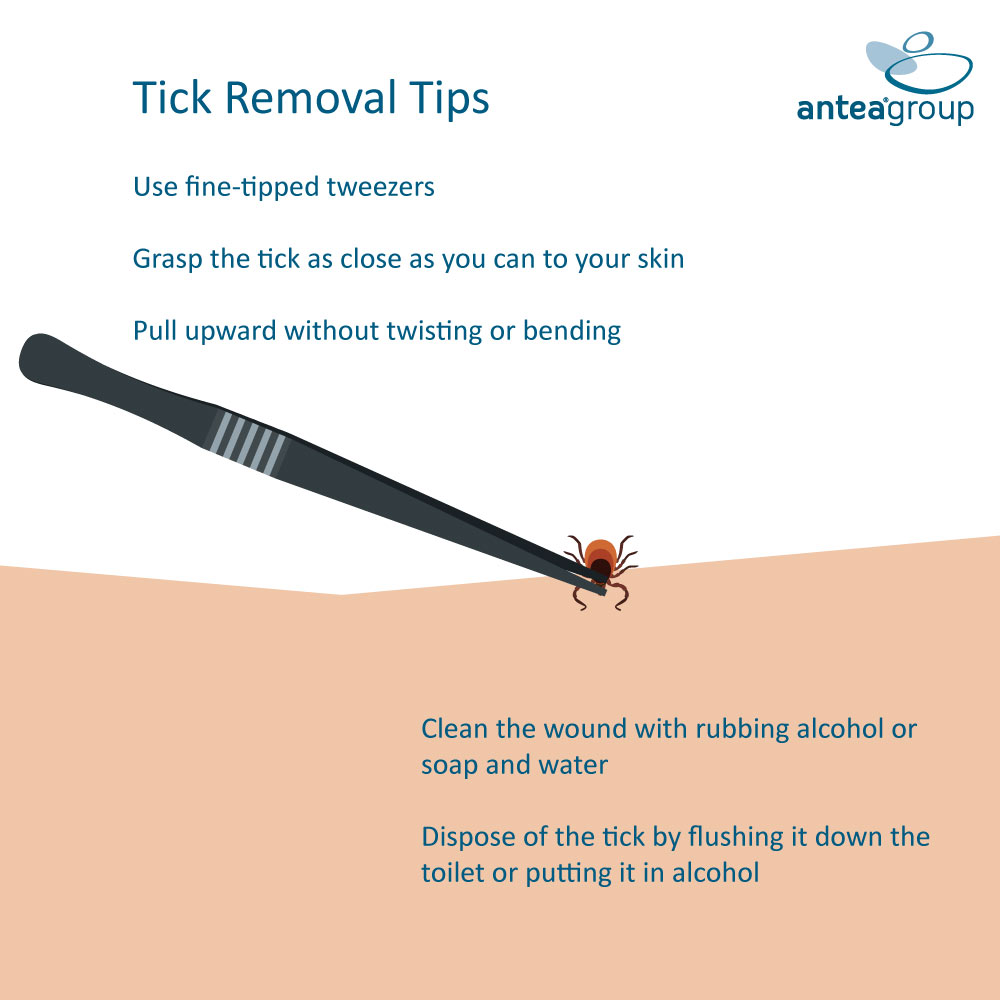Despite their small size, ticks present one of the biggest workplace safety hazards for field professionals and others who work outdoors.
Ticks are blood-sucking arachnids that get their nutrients from biting humans and other mammals, like dogs and deer. While ticks take on different physical characteristics during their lifecycles, they always have eight legs and can be brown, dark red, to black.
Ticks are a hazard because of their ability to transmit harmful diseases like Lyme disease, Rocky Mountain spotted fever, and Ehrlichiosis, as well as cause allergic reactions. With over 89,000 cases reported to the CDC in 2023, Lyme disease—with symptoms like rash, headache, fever, and joint pain—is the most common tickborne illness in the United States. But like all tickborne illnesses, it is 100% preventable if you take the appropriate safety measures before, during, and after working outside.
This tick health and safety guide provides knowledge, tips, and how-tos on how to avoid, check for, and remove ticks if you are bitten to help keep you safe at work this summer and fall.
Where and When Ticks are Out and About
Ticks can basically be found everywhere—they are spread throughout the United States, Canada, South America, and most other countries. They are most active from May to November any time the temperature is above freezing—when we are all outdoors doing the most fieldwork. Zoe Harvey, a writer and entomologist, says, “While most tick species have been known to stick to a set geographical range, entomologists have seen their distribution expanding, which may be caused by climate change and other factors. Because of these changes, it’s more important than ever to keep up with the CDC’s tick maps to ensure you know what kind of ticks live in the area you are working in.” Understanding which species of ticks live in the area you were bitten in is extremely important for diagnosing disease and other adverse reactions.
While the risk of tick bites is highest in late spring and summer, it’s important to remember that ticks can be active any time temperatures are above freezing. Outdoor workers should stay vigilant year-round, especially in regions where tick populations are expanding or active in multiple seasons due to changing climate patterns.
Typically, ticks are found in wooded, brushy areas full of tall grasses, and woodland border areas. They cling to plants while waiting for a host, and even though they have very small legs and no wings, they can move quickly on animals or humans. During different times of the year, their hosts may include deer, dogs, foxes, and rodents.
Common Tick Types in the U.S. and What They Carry
Several tick species pose risks to outdoor workers across the United States. Knowing the type of tick prevalent in your region can help in identifying potential illnesses and seeking prompt treatment.
Blacklegged Tick (Deer Tick)
The blacklegged tick, also known as the deer tick, is the primary carrier of Lyme disease, as well as Anaplasmosis and Babesiosis. These ticks are most commonly found in the Northeastern, Mid-Atlantic, and Upper Midwestern United States—particularly in states like New York, Pennsylvania, Wisconsin, and Minnesota. They are also increasingly detected in parts of the Southeast and expanding into new regions due to climate and habitat changes. Blacklegged ticks thrive in wooded and grassy areas and are most active from late spring through early fall, though they can bite anytime temperatures are above freezing.
Lone Star Tick
Found primarily in the Southeastern and Eastern U.S., including Texas and parts of the Midwest, the lone star tick is aggressive and known for transmitting Ehrlichiosis, Tularemia, and the Heartland virus. It’s also associated with a rare but serious red meat allergy known as Alpha-gal syndrome. Females are easy to identify with a distinct white dot on their back.
American Dog Tick
Commonly found east of the Rocky Mountains and in some parts of California, this tick species can transmit Rocky Mountain spotted fever and Tularemia. It prefers grassy areas and trails frequented by pets and humans.
Gulf Coast Tick
Primarily located in the Southeastern U.S. and along the Gulf of Mexico, this tick can transmit Rickettsia parkeri rickettsiosis, a disease similar to Rocky Mountain spotted fever but generally less severe.
Brown Dog Tick
Unlike most ticks, the brown dog tick can complete its life cycle indoors and is found throughout the U.S. It primarily targets dogs but can bite humans and is capable of spreading Rocky Mountain spotted fever, particularly in the Southwestern U.S.
Western Blacklegged Tick
Found along the Pacific Coast, particularly in Northern California, this cousin of the blacklegged tick also spreads Lyme disease and Anaplasmosis.
By familiarizing yourself with these species and the regions they inhabit, you can better understand your risk and act quickly in case of a bite. The CDC’s tick distribution maps are a valuable resource to stay informed as tick populations shift with changing climates.
A+ Avoidance Strategies
While tick bites might seem inevitable, we have several tips that are commonly accepted by health and safety professionals and the CDC to reduce your chance of encountering them on the job.
- Walk in the center of trails and avoid going through bushes, grass, or other vegetation. If you have to work in or near vegetation, trim or remove the plants before starting work.
- Treat your work clothes with 0.5% permethrin or buy pre-treated clothes. Studies show that permethrin treated clothing is an increasingly effective way to reduce tick bites. Do not use permethrin on your skin.
- Spray EPA-registered insect repellant (e.g. DEET, Picaridin, etc.) on your skin to deter ticks from attaching.
- We know it's hot in summer, but if the temperature allows, wear long sleeves and long pants and tuck everything in: shirt in pants and gloves as well as pants into socks and boots. This minimizes the amount of skin contact points for ticks.
- Shower as soon as possible after being outdoors.
What Employers Can Do to Protect Outdoor Workers
Employers play a critical role in reducing tick-related health risks on the job. In addition to encouraging safe work practices, organizations should proactively support field teams with resources and education:
- Provide safety training that includes tick identification, prevention, and removal.
- Distribute or recommend protective clothing—including long sleeves and pants treated with permethrin.
- Install signage in high-risk areas reminding workers to check for ticks.
- Stock first aid kits with tick removal tools and alcohol wipes.
- Encourage early reporting of tick bites and symptoms to ensure quick medical evaluation and reduce the risk of severe illness.
How to Do a (Successful) Tick Check
No matter if you were outside for a quick look at a site or a long visit taking soil samples, checking for ticks is a must.
Here are our top tick-check tips:
- Examine yourself as soon as you can after being outside. Many tick diseases take up to 24 hours to transfer and finding them as soon as possible reduces your risk of transfer considerably.
- Use a hand mirror or full-length mirror to check every part of your body for ticks. For places that are hard to see, use your hands to feel for bumps that weren’t there before.
- Check every nook and cranny: ticks often cling to warm, hard-to-see areas—use our Tick Hot Spots guide below to learn which areas to pay attention to.
- Go through your clothing and work gear and look for ticks, especially the folds and areas that are hard to see when you’re wearing them. Then, wash your clothes and dry them on a high heat.

It’s important to follow all the tips above to minimize the likelihood of contracting a tickborne illness. However, if you’re one of the many unlucky folks who find a tick on them: don’t panic. We'll walk you through how to remove it and what to do afterward.
Ditch Urban Myths, Here’s How to Safely Remove a Tick
There many urban myths about tick removal methods: varying from dangerous (set it on fire) to strange (cover it in nail polish). These methods are not safe or useful for removing ticks--when you are bitten, you want to remove the tick as soon as possible without damaging your own skin.
To safely remove a tick that has bitten you:
- Use tweezers and grasp the tick as close to your skin as possible.
- Pull directly up---try not to twist the tick.
- Check the bite to see if its mouthparts or head got stuck. If there is any part of the tick left, use tweezers to remove them.
- Clean the area with rubbing alcohol or soap and water.
Dispose of the tick by putting it in alcohol or flushing it down the toilet. If you want to keep the tick to show your physician for identification purposes, put it in alcohol to kill it and then put it in a sealed bag or container.

If you experience a rash, fever, or aches and pains in the hours or days after you are bitten, contact your doctor immediately. If you're unsure that your symptoms are from Lyme disease or other tickborne illnesses, check out the CDC's About Ticks and Tickbore Diseases Page. Depending on your employer and their rules on health and safety, reporting your bite to them might also be necessary.
Don’t Forget to Report It
If you're bitten, it’s not only important to monitor symptoms—but also to report the incident to your employer, especially if your company has workplace injury or exposure tracking requirements. Early documentation can support access to medical care, help identify high-risk areas on job sites and inform broader health and safety planning for your team.
Stay Tick-Free
If there is one moral to the story, it’s that you can never underestimate ticks and the impact they have on workplace safety. Use the strategies and tips laid out above to keep yourself, your employees, and your peers safe as they work outside this spring summer and fall.
Want more news and insights like this?
Stay in the loop with our monthly e-newsletter, The New Leaf. We’re here to keep you informed, enlightened, and entertained with the latest in EHS and sustainability. Don’t miss out on the insights and stories that matter to you!✨ Ready to turn over a new leaf? Sign up now!
Have any questions?
Contact us to discuss your environment, health, safety and sustainability needs today.




